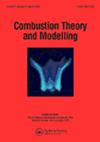离散化方法和化学动力学对提升氢火焰模拟精度的影响
IF 1.9
4区 工程技术
Q4 ENERGY & FUELS
引用次数: 2
摘要
本文在模拟氮气稀释氢气提升火焰在热共流中演变的基础上,对数值和建模问题进行了分析。我们将大涡模拟(LES)方法与所谓的“无燃烧模型”相结合,重点研究化学机制和各种离散化方案对所获得结果的影响。主要关注的是后一个问题,在这个问题中,我们分析了物质和焓的标量方程的对流项的离散化方法在多大程度上影响了解。我们考虑了八种常见的总变分递减(TVD)格式和三种二阶逆风格式。标量方程中的其余项和Navier–Stokes方程中的所有项均采用六阶紧致差分法离散化。这种方法使对流项的离散化误差成为影响数值解的主要因素。在主要分析之前,基于具有已知解析解的单个标量输运方程,强调了使用各种TVD或逆风格式所引起的差异。将获得的火焰结果与文献中的实验数据进行了比较。结果表明,由于应用特定离散化方法而产生的差异与模拟结果和实验数据之间的差异具有相似的大小。此外,对化学机制影响的分析表明,观察到的差异与使用不同离散化方法产生的差异相当。本文章由计算机程序翻译,如有差异,请以英文原文为准。
Impact of a discretisation method and chemical kinetics on the accuracy of simulation of a lifted hydrogen flame
This paper presents an analysis of numerical and modelling issues based on a simulation of nitrogen-diluted hydrogen lifted flame evolving in a hot co-flow. We apply the large-eddy simulations (LES) method with the so-called ‘no combustion model’ and concentrate on the impact of chemical mechanisms and various discretisation schemes on the obtained results. The main attention is put to the latter issue in which we analyse to what extent a discretisation method of the convective terms of the scalar equations for the species and enthalpy affects the solutions. We consider eight commonly known total variation diminishing (TVD) schemes and three upwind schemes of the second order. The remaining terms in the scalar equations and all the terms in the Navier–Stokes equations are discretised applying the sixth-order compact difference method. Such an approach makes the discretisation errors of the convective terms the main factor affecting the solutions from the numerical point of view. Prior to the main analysis, the differences caused by the use of various TVD or upwind schemes are highlighted based on a single scalar transport equation with a known analytical solution. The results obtained for the flame are compared to experimental data taken from the literature. It is shown that the differences due to the application of a particular discretisation method are of similar magnitude as the differences between the simulation results and experimental data. Moreover, analysis of the impact of the chemical mechanism showed that observed differences are comparable to these originating from the use of different discretisation methods.
求助全文
通过发布文献求助,成功后即可免费获取论文全文。
去求助
来源期刊

Combustion Theory and Modelling
工程技术-工程:化工
CiteScore
3.00
自引率
7.70%
发文量
38
审稿时长
6 months
期刊介绍:
Combustion Theory and Modelling is a leading international journal devoted to the application of mathematical modelling, numerical simulation and experimental techniques to the study of combustion. Articles can cover a wide range of topics, such as: premixed laminar flames, laminar diffusion flames, turbulent combustion, fires, chemical kinetics, pollutant formation, microgravity, materials synthesis, chemical vapour deposition, catalysis, droplet and spray combustion, detonation dynamics, thermal explosions, ignition, energetic materials and propellants, burners and engine combustion. A diverse spectrum of mathematical methods may also be used, including large scale numerical simulation, hybrid computational schemes, front tracking, adaptive mesh refinement, optimized parallel computation, asymptotic methods and singular perturbation techniques, bifurcation theory, optimization methods, dynamical systems theory, cellular automata and discrete methods and probabilistic and statistical methods. Experimental studies that employ intrusive or nonintrusive diagnostics and are published in the Journal should be closely related to theoretical issues, by highlighting fundamental theoretical questions or by providing a sound basis for comparison with theory.
 求助内容:
求助内容: 应助结果提醒方式:
应助结果提醒方式:


